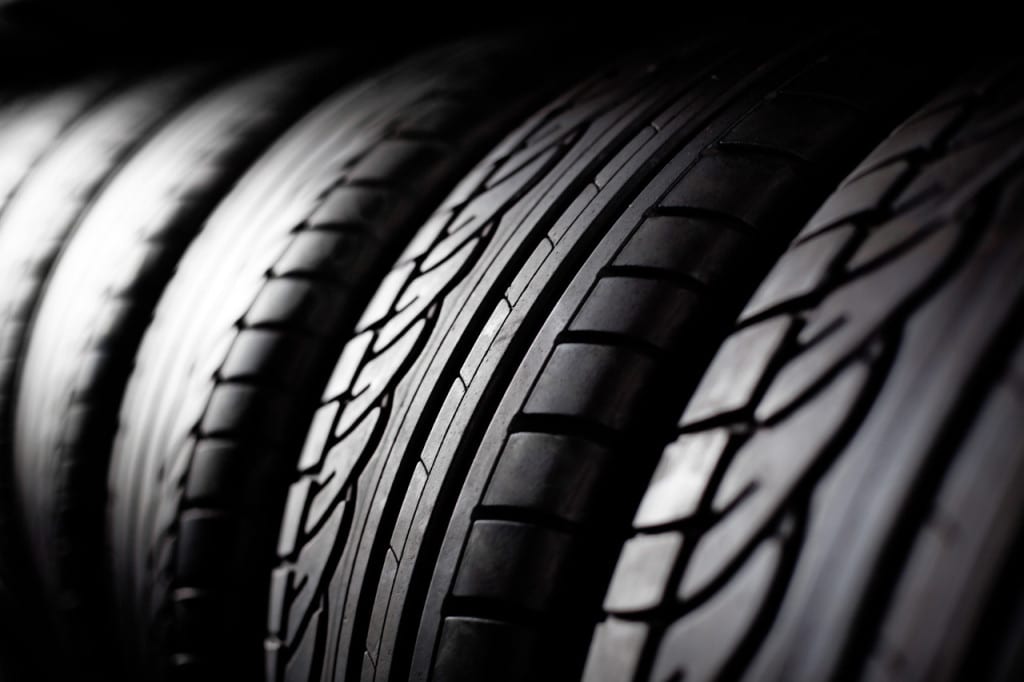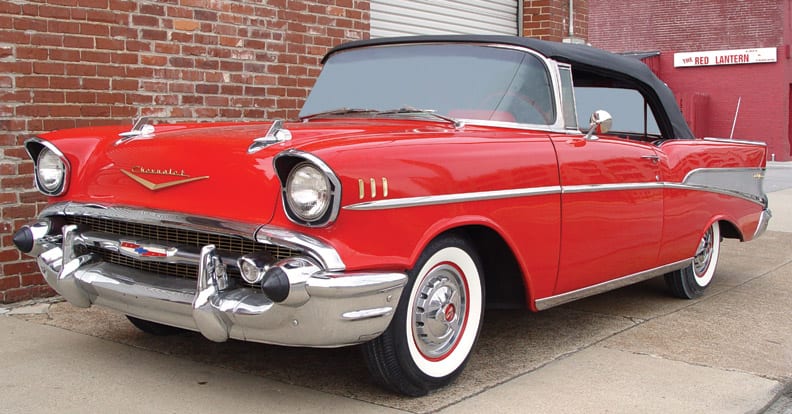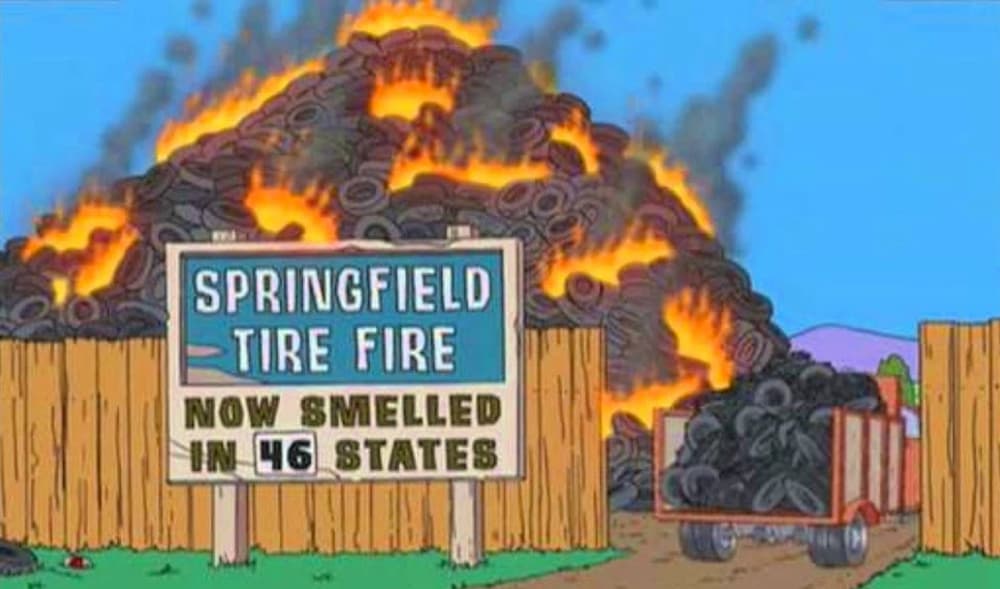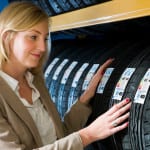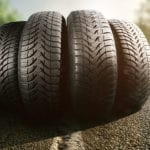Okay, so tires aren’t exactly sweeping the nation as a source of amazement. The only fun they offer is when you’re behind the wheel. And not behind the wheel in a chasing it with a stick on your way to the soda fountain kind of way, but behind the wheel as in the steering wheel.
Even then, when’s the last time you heard someone say, “sweet tires,” meaning “sweet ride?”
Right. Never.
Still, tires are absolute necessities and there are some fun facts that make them worthy of a second look. The next time you’re shopping for cheap tires, you’ll be reminded of these tire tidbits and probably won’t be able to stop yourself from sharing one or two with the sales associates.
Lucky them.
Historic Highlights
The next time you complain about changing a flat tire, think about the early production model cars, which came equipped with “artillery wheels.” The tire was bolted to the wheel and required Hulk-like strength to change.
Tires used to be white, due to the addition of zinc oxide, a strengthening agent which reinforced the rubber but turned the tires bright white. That must be the equivalent of a car sporting brand new bright white sneakers. Nerd alert!
Fortunately, researchers in the early 1920’s, in an effort to make tires even more durable, used carbon black to make tires more durable and long-lasting. Adding carbon black, compared to untreated rubber, increased the road-wear abrasion by almost 100 times and improved the tires tensile strength by as much as 1000%.
Carbon black, which is almost pure elemental carbon in colloidal particle form, is made by charring any organic material.
Treating tires with carbon black reduces thermal damage by conducting heat away from the tire’s hot spots on the treads and belts, which increases the life of the tire by reducing thermal damage.
Child’s Play
Who came up with this carbon black business?
The answer will surprise you.
Binney & Smith, which invented Crayola Crayons, sold their carbon black to the Goodrich Tire Company and white tires soon started to fade away as the superior black tires became favored and eventually commonplace.
These stronger tires now sported a tougher look. If white tires were the brand-spanking new sneakers of the automotive industry, black tires were the leather jackets.
The Whitewall Tires
In 1914, Chicago’s Vogue Tyre Company invented whitewall tires by melding a carbon black tread with a zinc white sidewall, making tires look not unlike Oreo cookies.
Premier tire-manufacturer, Goodyear, decided to take tire design up a notch in 1961 when it created the illuminated tire, which glowed soft white from the inside by glass incandescent bulbs. These tires never made it past the show circuit. Shocking.
Current Claims
Although it hinders performance, BMW equips most of its vehicles with run-flat tires. Run-flats are able to drive for up to 100 miles without air.
How? The thicker sidewall is able to support the weight of a vehicle, again, only for a short distance. But still.
Maybe run-flats could kill the tired plotline endlessly recycled by horror films: “driver with flat tire meets ax murderer.” Not if said driver had 100 extra miles to get to that always-elusive gas station!
Especially considering that new cars are rarely equipped with spare tires since manufacturers are always in pursuit of producing lighter vehicles. Instead of a spare, drivers are given patch kits with a can of compressed air. Imagine fighting off an ax-murderer with a few puffs from a can of compressed air. Best of luck.
The Stuff of Roadtrip Lore
The next time you want to truck the family cross-country for a road trip, don’t miss this sightseeing opportunity. Who wouldn’t want to check out the World’s Largest Tire?
Located in Allen Park, Michigan, the largest tire on the planet is a 12-ton, 80 foot-tall monstrous tower, able to withstand hurricane-force winds.
Initially unveiled as a Ferris Wheel during New York’s World Fair in 1964-65, this Uniroyal tire was relocated in 1966. Since then, legend has it that it broke loose and spun across I-94. As with all urban legends, there is absolutely no proof of this. But, what family road trip is complete without an urban legend or two? Gotta see how gullible those kids in the backseat really are.
Waste not, Want not
Every year, Americans dispose of 280 million tires. Of those, approximately 235 million are passenger car tires, 42 million are truck tires, and the remaining 3 million or so come from various equipment and aircraft tires.
This enormous source of waste inspired the creation of recycling programs which repurpose the old tires for a variety of uses. The good news is an estimated 25-30 percent of tires are somehow recycled in increasingly useful and creative ways.
A few of those ways include: melting down the rubber to repave asphalt, which actually improves the surface and helps extend the life of the road.
Once melted down, the rubber can then be ground into “crumbs” and added to sports and recreational facilities, like running tracks and playgrounds. Adding recycled tires to these surfaces prolong their lives up to five years.
Recycled tires can be used to make boat bumpers, carpet padding, and insulation.
Another popular repurposing option is to shred old tires for garden mulch and flower-bed lining.
Whether public building or private residence “green” construction uses recycled tires.
Depending on the overall wear and tear, some old tires can actually be recycled into new ones.
Timberland, the retail store specializing in footwear, has even partnered with Omni United, a tire manufacturer out of Singapore, to design a line of tires that can be made into the soles of new shoes.
This plan to recycle ahead of production is known as upcycling. The difference between recycling and upcycling is that upcycling involves planning for, rather than reacting to, the inevitability of tire waste.
Design Dreams
In addition to the sophisticated and surprising line of concept tires envisioned by various tire manufacturers, Michelin is developing a “tweel,” which is a one-piece airless wheel and tire. If successful, the tweel will put an end to flat tires…and horror movie ax murderers.
Rather than replacing the tweel the way you would a flat tire, Michelin is designing replaceable treads that would be changed as part of regular vehicle maintenance.
Built for Speed
So, tires have speed ratings of Y or Z. Ironically, Z-rated tires were introduced first, and had a speed rating of 149+ mph. Those short-sighted manufacturers must have blushed when technology upset their alphabet apple cart by creating a need for a higher rating because tires were developed to be even speedier. The highest rating of 186+ mph is a Y.
Tire Titans…and Toys
Goodyear, Michelin, Hankook, Bridgestone, Nokian, Pirelli, Toyo, the list goes on and on and on. Tire manufacturers can be found all over the world. But the biggest tire manufacturer is actually found in Denmark. Hans Christian Andersen’s homeland is also home of the world’s largest tire manufacturer: Lego. Yep, the little blocks. The toys.
Founded in 1932, Lego started manufacturing tires for its building block sets in 1962. In 2011, the company reported production of little tires at 318 million.
The next time you’re in the market for cheap tires, you’ll likely be reminded of Legos….and Crayolas…and maybe even Oreos.
Update: 6/13/2019
What’s in a Name?
If you’re in the incredibly small cross-section of people that are interested in tire facts and also passionate about etymology and the origins of words, then I have a treat for you… if you’re not, then I apologize in advance. There is actually some debate as to where the word “tire” comes from and how it was first coined. Really, though, there are two good theories on how we got the modern word that are both fascinating possibilities.
One of the most commonly accepted origins for the word “tire” is that it is derived from the word “attire,” which has roots in French and other romance languages going back to Latin. In this sense, the argument is that a tire is dressing on a wheel – much as clothing dresses a person, a tire dresses the outer ring of the wheel. Therefore, “attire” was simply shortened over time to “tire” in this particular usage.
Another possible origin, however, comes from how wheels have been made for hundreds of years. Prior to the use of modern rubber tires, old wheels on things like carts and cannons were made by constructing a hub with wooden spokes coming out from it toward an outer, circular frame. A metal band would be made by a blacksmith, measured out larger than the wheel itself. The band would be heated and placed onto the outside of the wheel; as it cooled, this band would shrink and compress the wheel, securing everything into place.
In other words, this outer band of metal would tie all the spokes into the hub and make the wheel complete and usable. So the band on the outside was a tie-er for the wheel, tying it all together. This sense of the word could have easily been used (that it was a tie-er) and over time simply became the modern word, “tire.”
One interesting note is that the word is spelled “tyre” in some English-speaking countries. Most evidence suggests this is actually a derivation and that “tire” is a more traditional spelling of the word in English. In fact, even though “tyre” has become the common spelling for the word in England, records dating back for hundreds of years show that it used to be “tire” and only changed over the course of the 20thCentury.
It should also be noted that “Tyre” is the name of an ancient Phoenician port city, now the name of a city in Lebanon. This has led some people to argue that the modern word “tire” is derived from “tyre” and therefore named after the city (suggesting tires could actually have originated there). There is no actual evidence to support this, however, especially when we consider how the change in spelling went from “tire” to “tyre” and not the other way around.
A Brief History of Goodyear
Goodyear is one of the most successful and among the largest tire manufacturers in the US and it has been around for more than 100 years. It was founded in 1898 on August 29 as the Goodyear Tire and Rubber Company, making tires for bicycles and carriages, as well as poker chips. Many people believe it was founded by Charles Goodyear, when in fact it was founded by a man named Frank Seiberling nearly 40 years after Goodyear died – he named the company after him because Charles Goodyear invented vulcanized rubber.
In the early 20th Century, Goodyear and other tire manufacturers in the US produced bias-ply tires, rather than modern radial types. In bias-play tires, the cords within the tire run at a 45-degree angle across the tire; while in a radial-ply or radial tire they run at a 90-degree angle across the tire. The French tire company Michelin first introduced radial tires for mass-market use; they quickly became preferred by drivers because they offer better mileage and performance. Goodyear embraced the change and switched to radial-ply design, which kept them competitive as the auto industry grew.
Today, Goodyear manufactures the tires for the Presidential limousine. Little is known beyond that fact, however, as the details and security measures used in those tires are classified. They also made the nitrogen-filled tires for the Apollo 14 Lunar Rover, which means there are Goodyear tire tread marks on the moon!
The Springfield Tire Fire
Since they are made from rubber, tires are notorious for burning hot and burning for a long time. Among the most famous tire fires in history is the Springfield Tire Fire, which legends claim has been burning for more than 25 years. In fact, at least one landmark in Springfield reads that the fire is so potent that the resulting fumes can be smelled by people in 46 different states across the country.
Of course, I’m referring to the town of Springfield from The Simpsons, not an actual fire in an actual town in the US. The Springfield Tire Fire has been featured in the opening sequence of The Simpsons for decades, and is one of the first things viewers can see while watching the show, after the title fades and the camera moves down out of the clouds. According to the lore of the show, and flashbacks shown in certain episodes, the tire fire was created by Krusty the Clown, who made the pile of unused tires after his attempted line of town cars failed, and then carelessly set it ablaze when he discarded a cigar onto the rubbery pile.
An episode in 1991 claimed the Springfield Tire Fire was celebrating its 25th year, which would mean it was started in 1966. Another episode from years later, however, claims it started in 1989, which is the year The Simpsons first aired. While I’m not too worried about timelines and Simpsons chronology, the point remains that the Springfield Tire Fire is a blazing landmark and point of dubious pride among many of the town’s residents.
The Legendary Nordstrom Tire
One of the most famous tires (or pairs of tires depending on the version of the story) in modern culture is the tire that features in an apocryphal tale of Nordstrom customer service. Nordstrom is one of the largest and most successful department stores in the US, with hundreds of locations across the country. Much of their success has often been credited to the fact that they have famously customer-focused policies including sending customers Thank You cards for their visits and very generous return policies.
One of the most famous stories in American business is that of a customer who returned a tire to a Nordstrom department store. The tale goes that the tire was returned by a customer in Alaska; he brought the tire in, said he was unhappy with it, and wanted a refund. The sales clerk who helped him looked at the tire, asked the man if he remembered how much he paid for it, and provided the man with a full refund without hesitation. The final detail of the story, however, is the fact that Nordstrom has never sold tires.
The idea, of course, is that the clerk cared more about making sure the customer was completely satisfied than whether the tire had actually been purchased there. While Nordstrom has made efforts in recent years to claim the story is true, most sources indicate it is a piece of apocrypha – a story that illustrates a point about excellent customer service, but is not really true. No one can say, definitively, whether it happened or not; but that tire remains a shining image burned into the minds of many successful business people, symbolic of the importance of putting the needs of the customer first.
